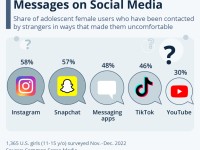Social Media Girls – At a downtown Toronto Starbucks, three twelve-year-old girls bustle around a table, their fingers flying over cell phone screens as they break from the daily grind of promoting their products. In between drinking iced tea lemonades and java-chip frappuccinos, they tell me how they run new content through test teams before releasing it to the world. They explain how this content is distributed and optimized for each platform and how it is carefully scaled to suit different audiences. They provide me with statistical tools that show them in real time how their messages are being received and how they are affecting their products in terms of reach and trust.
If it sounds like a full-time job, that’s because it’s a great job—a gig they’ve grown into because they’re teenagers in the smartphone age. As the three friends laughed and talked among themselves, their eyes were fixed on the ground, their shaved hair clutching the cars between their fingers. The brands they carry are theirs. They post carefully curated updates with their stylish photos on various apps and platforms. They swipe left and right, open and close apps, breathe in the daily drama unfolding on the bright screen, and plan their next move. They don’t see it as work – it’s more of a necessary pastime that has become normal, “it’s like breathing,” says 17-year-old Elina. Usually, they don’t even interfere with sleep.
Contents
Social Media Girls

“Especially when you’re talking to someone,” Yasmin, 16, said across the table. “Like, let’s say, a girlfriend. There is a lot of concern.”
Social Media An Easy Scapegoat
“Yes, you don’t sleep because you expect them to answer you. I did it,” says Elina, who also takes her phone into the bathroom in case there’s an important breakthrough during the shower.
Most of their social experiences are familiar to anyone who vaguely remembers being a teenage girl: waiting for the phone (taped to the wall), trying to look differently in the mirror, wondering if the crush is the same, panicking about missing out. to become opt out or reject. The difference is that in this generation, most of those experiences are filtered through whatever device they have on their phones. It’s time-consuming and taxing in a way that previous generations struggled with—because of the strategy involved, the relentless dedication, and the inability to go out without fearing you’ll be completely outmatched by your peers. These girls all got their first phones for one reason: Their parents wanted to call them when they were alone after school. Now the phone is an important part of their life. Elina says frankly: Her phone, she says, “is the fabric of my life.”
All this work, of course, is not paid, but it allows them to save state money – it depends on constant maintenance and prevention of wrong actions. Investing creates an “audience” of friends, friends of friends, friends of friends of friends, and strangers. The payment is probably partial. Surprisingly, recent studies suggest that other interactions may emerge. If you spend a lot of time building a product, are you sacrificing the product?
As the girls take me on a mysterious tour through their phones, it quickly becomes clear just how complex and sophisticated their online lives are – which helps explain the continued vigilance. For example, one Instagram account is not enough. Try two or five. Each girl has a very selected public account, which usually has a large audience and where only the best photos are posted (and only a few are posted at a time to control the photo). They each also have their own “spam” account, like a photo album of their life and experiences (you’ll never post a picture you posted on your main account “because you don’t get likes,” he says). There is “group spam” to record the life of a group of friends. There is an account for parents and family (banned from all other accounts) and a fake account designed to stalk old friends and ex-boyfriends invisibly.
Supereval » Blog Archive The Benefits Of Social Media For Students
They explain Instagram’s rules of etiquette, which define groups, relationships and social categories in code words, which can be difficult for unsuspecting parents. Elina opens the picture sitting on the bed. A quick click on a photo will bring up a series of tags with the names of Instagram users or groups of friends and acquaintances. The tags seem randomly scattered throughout the picture, but their placement is not random at all – they speak of Elina’s perception of the social world, including loyalty and alliances. “Tags are very important,” said Elina. My [names] are my best friends, next door are my friends, people who are there, I don’t consider them friends, but they look at my pictures.” Did you notice? This means that you are expected is to like and comment on the photo – and if you don’t, there could be drama. Not tagged? Wow. Elina says: “I had close friends, we’re a group of three, and then I lost those two friendships given because this event “happened”. “One of the girls didn’t get the tag, so ‘I guess we’re not friends anymore’.”
The seventeen-year-old from Mississauga, Ont., decided on an Instagram account. To be sure of each message, he sometimes contacts his friends in a group chat before clicking “share”. “Anytime we say, ‘I’m going to post — do you think it’s appropriate?’ Do you think this is suitable for Instagram? “Nashra said.
Elina and her friends do the same. They consider at least 500 likes within 48 hours as the benchmark for a successful post, and see anything less as a sign that the content isn’t resonating with their audience. Using analytics programs very similar to stock tickers, they monitor wavy lines that show audience engagement in real time. Yasmin connects with her Instagram account: there are 110 new followers to report, and the “followers lost” tab shows that she lost seven at a time.

If they’re not Instagramming, they’re Snap-chatting (not, after all, Facebook or Twitter—the two platforms they’ve been given). The photo-sharing, instant messaging and video chat app allows users to send a photo to an entire group or to a specific person, then deletes its content after viewing it (unless one of your followers is quick enough) to take a screenshot. . screenshot). However, it does show who has seen the user’s stories, so girls know for sure that their date or friend is viewing all the comments sent to their followers.
How To Create 3d Ai Social Media Girl Images Using Bing Ai
“I like it because you can sneak up on people and if someone is hurting you, you can send things to show that you’re happy with your life,” Negar said. “Let’s say you have your ex on Snapchat,” Yasmin adds. “You always make sure you look your best or do something fun.” With a deliberately blurry image, what is really a cold night can become something interesting.
These young people are very aware of their audience and how difficult it can be to communicate with their friends on social media. Don’t answer when you call, if you don’t touch that heart when it’s expected of you, can you really be a best friend? And if you’re not up to the task, how can you expect your friends to be there the next time you get the chance to post something? This can mean termination or public termination. “FOMO, I think is a really big thing in our generation,” Yasmin said, using the acronym for “fear of missing out.” “Missing me, especially, that’s the worst thing,” he said. “I’d rather give up than [not]. . . . And family, they are always there. Friends, it’s not like that.”
Fifteen-year-old Lexi can handle this pressure. A teenager from Burnaby, BC, always has her notifications on so she knows when her friends are trying to make plans with her on Snapchat, their primary form of communication. “Streaks” – long chains of photos and photos that your friends post in response – count as a measure of popularity. “The more stripes you have, the cooler you are,” Elina said. Snapchat starts and records a back-and-forth with a friend two days in a row. It doesn’t matter if the messages are well-formed or a blank screen – they are sent only to maintain the thread. The longer the chain, the higher it is in the strip list. And having a long list of streaks is proof that you are strong with certain people. (A Toronto teenager tells me at one point
Social girls, social media scheduling tool, social media advertising companies, american girls social media, social media posting tools, best social media tools, social media marketing platform, social media posting software, later social media scheduler, social media audience analysis, social media analysis, social media scheduler











